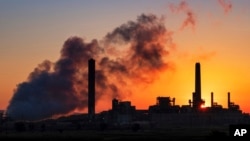Carbon dioxide (CO2) emissions from the world’s electric power industry fell by two percent last year, a study shows. That represents the biggest decrease in such emissions since at least 1990.
The study comes from the International Energy Agency, or IEA, which is based in Paris. It found that the decrease in emissions largely resulted from reduced coal usage in Europe and the United States, which burn coal to generate electricity.
The IEA reports that the electricity-generation industry produced 36 percent of all energy-related emissions in developed economies. The study showed that the United States reduced its CO2 emissions by 140 million tons -- the largest amount of any country.
Additional data from a climate research group showed that coal-generated electricity around the world fell by three percent in 2019. The Ember research group noted that coal use in Europe dropped by 24 percent, while it dropped 16 percent in the U.S. China was responsible for half of the world’s coal-generated electricity.
In 2019, coal use decreased in many areas, including Japan and South Korea. Both countries have increasingly turned to natural gas and nuclear energy for their power needs.
Dave Jones helped write the report by Ember. Jones told the Reuters news agency that the worldwide reduction in coal use is “good news for the climate,” but he said governments should do more.
“To switch from coal into gas is just swapping one fossil fuel for another,” he said.
Coal, oil and other fossil fuels are all carbon-based and thought to increase CO2 in Earth’s atmosphere.
In a statement, the IEA said the world’s total emissions remained unchanged, although the world’s economy grew 2.9 percent in 2019.
Renewable energy increasing
Wind and solar energy generation increased by 15 percent last year. Hydroelectric power and nuclear energy also do not add CO2 emissions to the atmosphere.
The report examined information covering 85 percent of the world’s electricity generation in the world’s largest economies. Researchers estimated the remaining 15 percent.
The IEA found that energy-related CO2 emissions have been decreasing in the United States, the EU and Japan. However, emissions in the rest of the world have risen since 2018.
I’m Mario Ritter, Jr.
Nina Chestney reported this story for Reuters News Agency. Mario Ritter Jr. adapted it for VOA Learning English. George Grow was the editor.
________________________________________________________________
Words in This Story
emissions – n. something that is released into the atmosphere, often a gas related to fuel use
generate – v. to produce something or to cause something to be produced
data – n. factual information used for making estimates
swap – v. to exchange one thing for another
hydroelectric – adj. relating to production of electricity by waterpower







